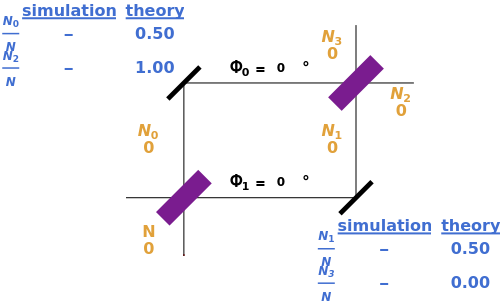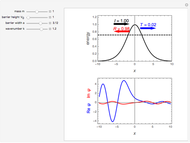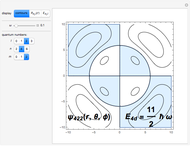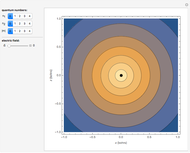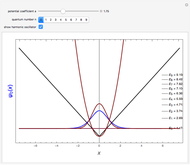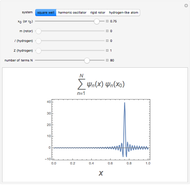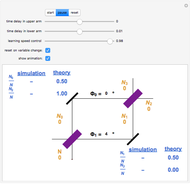Event-by-Event Simulation of the Mach-Zehnder Interferometer

Requires a Wolfram Notebook System
Interact on desktop, mobile and cloud with the free Wolfram Player or other Wolfram Language products.
This Demonstration shows that it is possible to construct classical dynamical systems that do not rely on any concept of quantum theory, yet that display the same interference patterns as those observed in single-photon Mach–Zehnder interferometer experiments. The detectors  ,
,  ,
,  , and
, and  are the cumulative counts of photons until they are reset.
are the cumulative counts of photons until they are reset.
Contributed by: Tim de Jong and H. De Raedt (March 2011)
Open content licensed under CC BY-NC-SA
Snapshots
Details
The Mach–Zehnder interferometer was originally conceived as a device to measure the refractive index of an object placed in one of the arms of the interferometer [1].
A light beam along the line labeled  is split in two by a half-silvered mirror, represented by the left-most purple block. The two resulting beams are each reflected by a mirror (thick black line).
is split in two by a half-silvered mirror, represented by the left-most purple block. The two resulting beams are each reflected by a mirror (thick black line).
Changing the time delay  (
( ) in the upper (lower) arm of the interferometer changes the phase
) in the upper (lower) arm of the interferometer changes the phase  (
( ) of the lightbeam in this arm, according to
) of the lightbeam in this arm, according to  (
( ) (dimensionless units). According to Maxwell's classical theory of electrodynamics, the beams interfere in the second half-silvered mirror and the resulting signals registered by the two detectors at the end of the lines labeled
) (dimensionless units). According to Maxwell's classical theory of electrodynamics, the beams interfere in the second half-silvered mirror and the resulting signals registered by the two detectors at the end of the lines labeled  and
and  show interference patterns,
show interference patterns,  and
and  , respectively [2].
, respectively [2].
Generally, it is accepted that interference is a typical wave phenomenon. On the other hand, it is an experimental fact that when the experiment is carried out one photon at a time, the number of photons recorded at each detector agrees with the prediction of Maxwell's theory [3]. However, at any time there is only one photon traveling from the source to the detector and it has been shown experimentally that each individual photon travels along one path only [3]. Quantum physics "solves" this dilemma by introducing the concept of particle-wave duality.
This Demonstration shows that classical, event-based processes that satisfy Einstein's criterion of local causality [4] can provide an alternative interpretation of results conventionally attributed to quantum effects. In the simulation, the photons are regarded as messengers that travel from the source to a detector. The message carried by a messenger may change as the messenger encounters another object, such as a beam splitter. In this Demonstration, only the beam splitters update the messages. The key point of the update algorithm is that it defines a classical, dynamical system that has a primitive learning capability. In this Demonstration, the user can control the speed or accuracy of the learning process in each beam splitter.
References:
[1] M. Born and E. Wolf, Principles of Optics, Cambridge: Cambridge Univ. Press, 2005. [2] T. L. Dimitrova and A. Weis, "The wave-particle duality of light: A demonstration experiment," American Journal of Physics 76(2), 2008. [3] P. Grangier, G. Roger, and A. Aspect, Europhys. Lett. 1(173), 1986. [4] H. De Raedt, K. De Raedt, and K. Michielsen, "Event-Based Simulation of Single-Photon Beam Splitters and Mach-Zehnder Interferometers," Europhys. Lett., 69, 2005 pp. 861–867.
Permanent Citation
